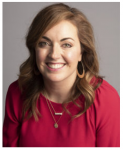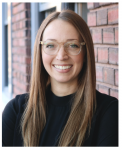Look Book Issue 3 | Be Well 20/20 | WELL Accredited Professionals Q+A
Q+A WITH WELL ACCREDITED PROFESSIONALS, EMILY TILGNER + LAUREN NORTH
For decades, the AEC community has focused on implementing sustainable and responsible building design practices. Organizations use rating systems to determine the level of certification each structure can achieve. A few of these systems include USGBC’s LEED, or International Living Future Institute’s Living Building Challenge & The Red List. More recently, there has been a growing awareness towards enhancing the wellbeing of the individual occupants. Adding this layer of thoughtful design has created more checks and balances to ensure the care and maintenance of not just our environment, but the people as well. Since 2014, the International Well Building Institute has been advocating and educating professionals on the importance of a creating an interior environment that advances human health and wellness.
To date, 14,650 (and counting) professionals have dedicated their time to achieve the title of WELL Accredited Professional. Scott Rice reached out to two of our industry partners, Emily Tilgner and Lauren North, to share their reason for obtaining WELL AP titles and what it means to them to share their expertise.
What does being a WELL accredited professional mean to you?
ET: For me, it is an awareness that as a member of the AEC industry, we can have an impact on the well-being of people, not just their buildings. It is taking a holistic view of the entire process in order to make something not only functional but beneficial as well.
LN: Being WELL accredited means taking one step further towards creating an environmentally-conscious industry. It’s an extension of my passion to gain knowledge about how to better design for our environment, and having the knowledge to share in ways that will make a difference – from my own personal design decisions, to conversations with coworkers and clients.
Why was it important for you to dedicate your time to becoming WELL accredited?
ET: I have always been interested in design that pushed beyond the bare minimum. LEED and green design was the first exposure I had to any standardized method of achieving something more. WELL seemed to me to be the next evolution of what design could be.
LN: I felt WELL’s interpretation of sustainability spoke to my personal belief about how we should design. In my college career there wasn’t a heavy focus on sustainability- so a more in-depth study was beneficial to my knowledge base. It’s important to know that the accreditation is meant to be a continuous journey. It doesn’t stop with a passed test – it’s an ongoing path of learning, growth, and connecting with your community.
Are you having conversations with your clients about WELL Building Certification? What has been their response?
ET: Yes, we have. I think there is still some mystery about what WELL is and what a WELL accredited building can be. Many clients are interested, but I feel that there needs to be more exposure and understanding and a push that occupants want these features in their buildings.
LN: While conversations about sustainability and WELL do happen, we have room to grow with the general acceptance of WELL (or LEED, or Fitwel, etc) – mostly regarding justification of the cost of project certification. Even if the effort doesn’t make it past the introduction, being WELL accredited allows you to implement design ideas that do not require any extra cost. Every project can have the content of a sustainable project without the label.
Since becoming accredited, have you noticed more awareness in implementing these values in your day to day at the office? How about at home?
ET: Personally, I have definitely become more aware. Some of the statistics and information regarding the optimizations really shine a light on how our surroundings can affect our overall health. Daylight exposure, biophilia and placement of healthy food options are just a few that I’ve worked on improving in both the office and the home.
LN: Absolutely. If you are interested enough in the environment to take the WELL exam, you are most likely already considering earth-friendly choices in almost all you do. The accreditation brought light to the ‘why’ behind various concepts, which makes it easier to integrate into daily practice.
How can we become more aware of the importance of WELL standards?
ET: More of what you all are doing! More exposure, training, conversations all help to make it as well-known as LEED. However, the distinctions between the influx of ratings programs needs to be understood in order to find which program is the best fit for the client/project.
LN: Stay engaged in the community, keep sustainability conversations alive, and find allies who can educate you in both how to integrate WELL into your projects and how to have these important conversations with clients. The more we can actively keep the discussion open, the more accepted it will be to design through the environmentally-responsible lens.
Do you have any tips and tricks for professionals to implement WELL standards when they are working from home?
ET: I try to focus on the small things. I brought in multiple plants to my home office, arranged my desk to have daylight views and try to take multiple mini breaks throughout the day to encourage movement.
LN: There are so many ideas based on the WELL standards you can start implementing into your WFH situation. Limiting your power use by taking advantage of daylight, adopting composting, replacing sugary pantry snacks with fruit, or even experimenting with rainwater collection are just a few ideas. WELL is heavily focused on the user – so, to me, it’s even more important to make sure you are supporting yourself in healthy ways during this time. Setting screen time boundaries, taking mental breaks, creating a comfortable workspace, and taking moments outdoors are important, too. While at home I’ve loved making adaptations to this new way of functioning, because sustainability also pertains to livability and ultimate balance. Edit your home to make things easier for you in this current situation. Exploring how your home can be a flexible environment is a similar exercise to what we do for clients on the regular.
Interested in becoming a WELL AP? Become a WELL AP | WELL Accredited Professional | IWBI (wellcertified.com)
How to get started; The WELL AP Process – How to Become a WELL AP | IWBI (wellcertified.com)
Special thank you to our contributors, Emily and Lauren for taking the time to be a part of our Be Well 20/20 Look Book!
Emily Tilgner, P.E. , QCxP, WELL AP
Vice President, Engineering Services at McCOWNGORDON
etilgner@mccowngordon.com
Lauren North, IIDA, WELL AP
Interior Designer, HOK
lauren.north@hok.com
FOR MORE OF OUR BE WELL 20/20 LOOKBOOK, CLICK HERE!



